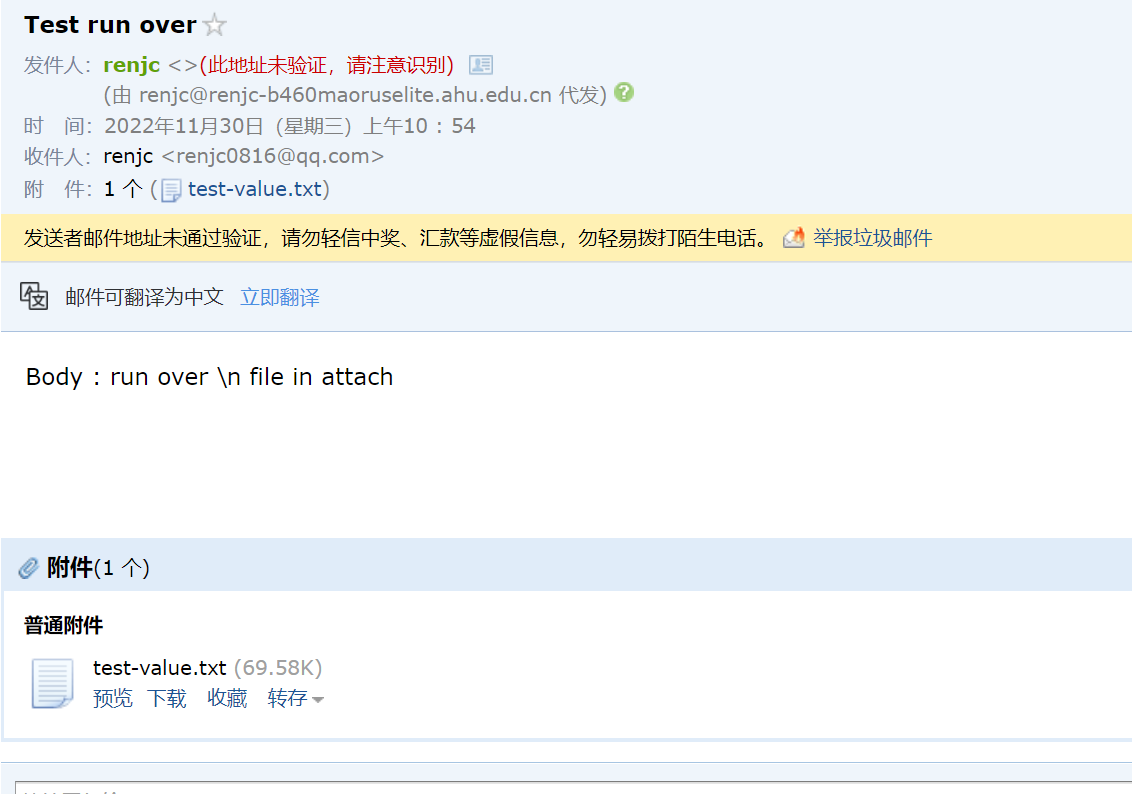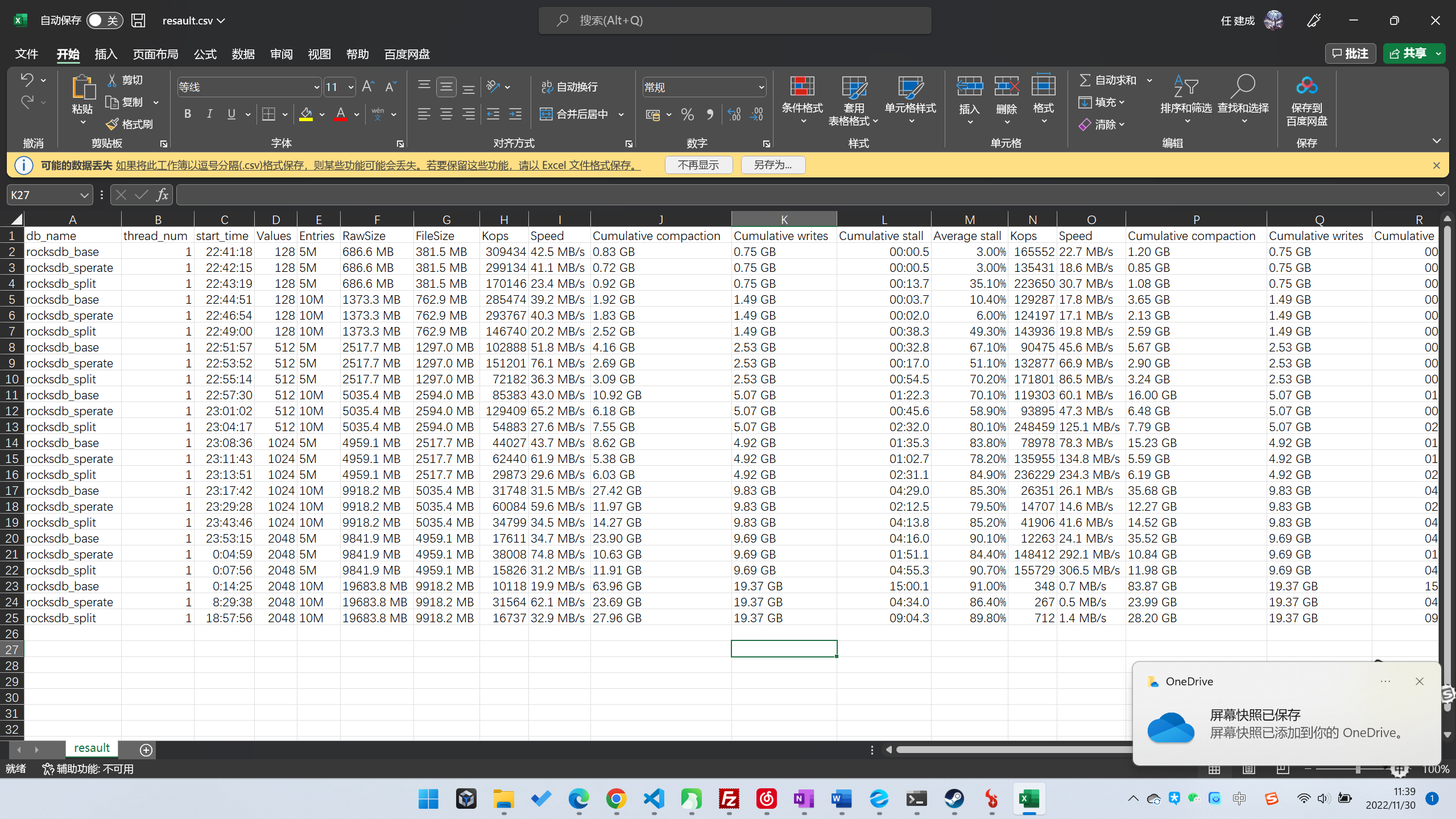自動跑測試記錄後傳送郵件提醒並自動解析資料
使用指令碼自動跑實驗(Ubuntu),將實驗結果記錄在檔案中,並在實驗結束之後將結果通過郵件傳送到郵箱,最後在windows端自動解析成excel表格(因為要在windows的origin上作圖)。
SHELL
touch run.sh #建立但不編輯指令碼
chmod 777 run.sh #給予指令碼執行許可權
gedit run.sh #編輯指令碼- 指令碼中可以建立變數,如直接
x='100'或r='rm -rf'即可,${x}在執行的時候以字串形式讀取。
- 注意變數建立時使用單引號,等於號前後不要有空格,可以是命令,可以使變數,反正都是字串。
- 如何以數位方式解析變數?被以
$(())包裹的變數將以數位形式解析,比如在某行中有這個引數:--num=$((${n}*1000000)),這裡${n}將被以數位形式解析。 - 變數為路徑:建議使用絕對路徑。如想建立用於接收結果檔案
receive='/home/renjc/easy-test2.txt'之後touch ${receive},當然變數本質上是以字串形式讀取的,用receive='../xx.txt'當然也行,還更靈活,就是程式容易整錯。
- 指令碼中若想執行命令,直接新一行然後將命令打上去就可以了,不需要額外的東西,指令碼本質上還是一行一行執行的
- 若命令中想帶引數,可以直接用變數替換
- 陣列,
volumn='128 512 1024 2048'即是陣列,也可以當做一串字串來解析。
#遍歷陣列,迴圈,遍歷資料夾
workloads="./works/workloada.spec ./works/workloadb.spec ./works/workloadf.spec"
for file_name in $workloads; do
./ycsbc -db redis -threads 1 -P $file_name
done
#下面這個是單純的for迴圈
for ((tn=1; tn<=8; tn=tn*2)); do
doneworkload
#下面這個是遍歷資料夾workload_dir中所有以workload開頭的spec檔案
for file_name in $workload_dir/workload*.spec; do
done- 函數,函數直接寫在執行前就行
#函數作用是記錄name,當前時間,以及初步計算value
recordstart(){
time=$(date)
echo "db_name: ${1}" >> ${receive}
echo -n "start_time: ${time} and Value:" >> ${receive}
echo "scale=2;${3}*${4}/1024/1000"|bc >> ${receive}
#純shell對除法的支援比較粗糙,如果想要保留兩位小數,可以向上面這行一樣。
}$(date)代表當前時間,帶年月日時分秒的那種。- shell指令碼的函數引數並不需要申明什麼的,
${1}就代表函數第一個引數,以此類推,其中按照慣例,${0}代表函數名(或者說程式名)。呼叫函數也很簡單,recordstart name ${v}即可呼叫,函數名後面的都是引數,在函數中使用${1},${2},${3}識別。 echo -n "xx" >> ${receive},只有echo的話,會輸出到控制檯中,加上>> ${receive}會輸出到這個檔案裡面,加上-n代表這一行不換行,因為echo預設是每次都換行的。
使用以上幾種組合基本可以完成絕大部分實驗與程式。以下作為例子
這個作為例子(已摺疊,可展開) receive='/home/renjc/spkv/resault/easy-test2.txt'
touch ${receive}
ulimit -Sn 16384
ulimit -Hn 32768
#解除堆疊限制,可能需要,先預備
rocksdb_base='rocksdb-base/db_bench'
rocksdb_split='rocksdb-split/db_bench'
wisckey='WiscKey-master/WiscKey/out-static/db_bench'
# database="${rocksdb_base} ${rocksdb_split} ${wisckey}"
rmstore='rm -rf /home/renjc/spkv/db/*'
recordstart(){
#${1} db_name,${2} number of threads,${3} value_size,${4} number of rows
time=$(date)
echo "db_name: ${1}" >> ${receive}
echo "thread_num: ${2}" >> ${receive}
echo "value_size: ${3}" >> ${receive}
echo "num:${4}" >> ${receive}
echo "start_time: ${time}" >> ${receive}
echo -n "resault GB is:" >> ${receive}
echo "scale=2;${3}*${4}/1024/1000/1000"|bc >> ${receive}
}
recordend(){
time=$(date)
echo "done_time: ${time},----clean store and sleep 10s-------------------" >> ${receive}
${rmstore}
sleep 10s
}
#rocksdb 用一個槓兩個槓都行,leveldb/wisckey只能用兩個,統一採用兩個槓槓。
const_arg='--db=/home/renjc/spkv/db --bloom_bits=0 --write_buffer_size=134217728'
rocksdb_arg='--compression_type=none' #Wisckey do not support but rocksdb need
sperate_arg='--enable_blob_files=true' #rokcsdb的鍵值分離版本就是原來的版本上加一個引數,所以使用相同路徑加一個引數
benchmarks='--benchmarks=fillrandom,stats,readrandom,stats'
volumn='128 512 1024 2048'
num='5 10'
echo "test start" >> ${receive}
for v in ${volumn}
do
for n in ${num}
do
recordstart r_sperate 1 ${v} 10000000
./${rocksdb_base} ${const_arg} ${rocksdb_arg} --num=$((${n}*1000000)) --value_size=${v} ${benchmarks} ${sperate_arg} >> ${receive}
recordend
recordstart r_split 1 ${v} 10000000
./${rocksdb_split} ${const_arg} ${rocksdb_arg} --num=$((${n}*1000000)) --value_size=${v} ${benchmarks} >> ${receive}
recordend
recordstart wisckey 1 ${v} 10000000
./${wisckey} ${const_arg} --num=$((${n}*1000000)) --value_size=${v} ${benchmarks} >> ${receive}
recordend
done
done
echo "all done" >> ${receive}
echo "run over \n file in attach" | mutt -s "Test run over" [email protected] -a ${receive}自動傳送郵件
mail如何新增附件沒整成功,現在使用mutt命令實現,控制檯執行:
sudo apt-get install mutt安裝
echo "Body : run over \n file in attach" | mutt -s "Test run over" [email protected] -a 'path'即可。
其中,"Body"開頭的是郵件內容,-s後面的是郵件標題,-a後面的'path'是附件地址,正常使用不用帶單引號,寫在指令碼裡時可以用之前建立的${receive}代替。郵件是立刻傳送的,收件箱裡找不到請到垃圾箱裡面找找。如下:

自動解析實驗結果生成excel表格
這個程式自己寫去
如何生成excel可讀取的檔案?csv檔案:csv檔案可以被excel讀取,第一行表示excel的那個列名,用逗號分割,底下的資料也是,每一行代表excel表格內的一行,每一列的內容用逗號分割,英文的逗號。
至於解析實驗結果,就逐行讀取,然後捕捉自己想要的關鍵詞就行了,效能啥的就不用考慮優化了,咋簡單咋來。
下面的是自用的解析rocksdb的引數的,僅供參考
自用rocksdb引數解析(已摺疊,可展開) #include <iostream>
#include <string>
#include <sstream>
#include <vector>
#include <fstream>
#include <iomanip>
#define default_file_path "E:\\Code\\Windows\\FileOperate\\easy-test.txt"
#define resault_file_name "E:\\Code\\Windows\\FileOperate\\resault.csv"
using namespace std;
struct arguments {
arguments(string s,string t):name(s),data(t){}
string name;
string data;
};
void readFile(vector<arguments>& resault,const string& file_path);
void trimEmpty(string &s);//用於去除字串首尾空格
void recordString(const string& type, string& s,vector<arguments>& resault);//用於格式化並記錄data
void recordInFile(const vector<arguments>& resault);//解析結果記錄到檔案中,測試用
void recordCSVMode(const vector<arguments>& resault);
void printInShell(const vector<arguments>& resault);//列印到控制檯,測試用
//按順序存放需要捕捉的關鍵詞,問題在於只能順序
//如果該行以該關鍵詞結尾,那麼就將所有的東西記錄下來
//注意,這個陣列並不是最終引數結果,有的一行記了兩三個引數
const static vector<string> key_words = {"db_name","thread_num","start_time","Values","Entries","RawSize","FileSize",
"fillrandom","Cumulative compaction","Cumulative writes","Cumulative stall",
"readrandom","Cumulative compaction","Cumulative writes","Cumulative stall","done_time"};
const static int length = key_words.size();
int main(int arg_count, char *arg_value[]){
string file_path = default_file_path; //預設路徑
if(arg_count > 1) file_path = arg_value[1];
//argv[0]為程式名,這點由shell傳統決定,argv[1]是程式名的輸入
vector<arguments> resault;
readFile(resault,file_path);
// printInShell(resault);
// recordInFile(resault);
recordCSVMode(resault);
// getchar();
return 0;
}
void readFile(vector<arguments>& resault,const string& file_path){
int flag = 0;
string line;//按行讀取
ifstream fp(file_path);
while(getline(fp, line)) {
string head = line.substr(0,line.find(":"));
trimEmpty(head);
if(key_words[flag] == head) {
string tail = line.substr(line.find(":")+1);
recordString(key_words[flag],tail,resault);
// resault.push_back(arguments(key_words[flag],tail));
flag = flag == length - 1 ? 0 : flag + 1;
}
}
}
void trimEmpty(string &s){
//刪除字串的前後空格
if (!s.empty()){
s.erase(0, s.find_first_not_of(" "));
s.erase(s.find_last_not_of(" ") + 1);
}
}
void recordString(const string& type, string& s,vector<arguments>& resault){
//為什麼不使用精確的下表標位置
//因為資料的長度不一定,所以必須使用標點符號等來相對定位。
trimEmpty(s);
if(type == "fillrandom" || type == "readrandom"){
int start = s.find("op")+3;
int len = s.find(";") - start;
string kops = s.substr(start,len);
resault.push_back(arguments("Kops",kops));
start = s.find(";")+1;
len = s.find_last_of("s")+1 - start;
s = s.substr(start,len);
trimEmpty(s);
resault.push_back(arguments("Speed",s));
return;
}
if(type == "Cumulative stall") {
string stall_time = s.substr(0,s.find(" "));
resault.push_back(arguments("Cumulative stall",stall_time));
s = s.substr(s.find(",") + 2);
resault.push_back(arguments("Average stall",s));
return;
}
if(type == "start_time" || type == "done_time"){
s = s.substr(s.find_last_of(":")-5,8);
}else if(type == "Values"){
s = s.substr(0,s.find(" "));
}else if(type == "RawSize" || type == "FileSize"){
s = s.substr(0,s.find_last_of(" "));
}else if(type == "Cumulative compaction"){
s = s.substr(0,s.find(" ")+3);
}else if(type == "Cumulative writes"){
int start = s.find_last_of(":") + 2;
int length = s.find_last_of(",") - start;
s = s.substr(start,length);
}
resault.push_back(arguments(type,s));
return;
}
void recordInFile(const vector<arguments>& resault){
ofstream record;
remove(resault_file_name);
record.open(resault_file_name, ios::app);
for (size_t i = 0; i < resault.size(); i++) {
record << left << setw(25) << setfill(' ') << resault[i].name;
record << resault[i].data << endl;
}
}
void recordCSVMode(const vector<arguments>& resault){
//key_words的長度並不是最終引數的數量
ofstream record;
remove(resault_file_name);
record.open(resault_file_name, ios::app);
size_t point = 0,point_t = 0;
string head = resault[0].name;
while(resault[point+1].name != head){
record << resault[point++].name << ",";
}
record << resault[point].name << endl;
for (size_t i = 0; i < resault.size(); i++) {
if(point_t < point) {
++point_t;
record << resault[i].data << ",";
} else {
point_t = 0;
record << resault[i].data << endl;
}
}
}
void printInShell(const vector<arguments>& resault){
// 格式化輸出,left表示偏左,setw是設定寬度,stefill是設定填充字元
for (size_t i = 0; i < resault.size(); i++) {
cout << left << setw(25) << setfill(' ') << resault[i].name;
cout << resault[i].data << endl;
}
}解析結果如下(這個花花綠綠的顏色是vscode的外掛,建立csv檔案之後就會提示安裝)

excel可以直接開啟,wps沒下就沒試。excel開啟如下:

剛開啟可能資料顯得有點擁擠,可以另存為excel正常的格式進行調整,要不然調整了這csv檔案也儲存不下來的。
好了,這波整完就可以開始摸魚啦把實驗放那跑,跑完手機會收到郵件提示,回去自動解析一波就行,至於更多的分類啥的功能,都可以在程式中實現。
(>.o)